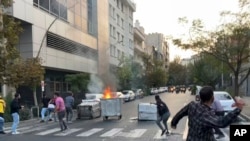Iranians have intensified their protests against last week’s death of a young woman detained by police enforcing Iran’s strict hijab rules, spreading their demonstrations to more parts of the country and engaging in bolder acts of defiance toward their Islamist rulers.
Citizen journalist videos posted to social media appeared to show Iran’s latest anti-government protests reaching at least 16 of its 31 provinces on Tuesday, a big jump from the handful of provinces seen in protest videos posted to social media in the previous four days.
VOA cannot independently verify the circumstances of the protests because it is barred from reporting inside Iran.
The protests began on Friday with demonstrators gathering outside a Tehran hospital shortly after it confirmed the death of 22-year-old Mahsa Amini, a member of Iran’s Kurdish minority from the northwestern town of Saqez in Kurdistan province.
Family members had reported that Iran’s morality police arrested Amini as she visited Tehran on September 13. They said police accused Amini of improperly wearing her hijab, or headscarf, and took her in a van to a police station where she fell into a coma while in detention with other women.
Amini’s relatives accused Iranian police of physically abusing her in custody and rushing to stage her funeral in Saqez on Saturday without sharing results of an autopsy. Authorities denied mistreating Amini and blamed her death on heart problems. Her family said she had no history of heart problems.
Since Friday, VOA’s Persian Service has compiled protest videos emerging from the provinces of Alborz, East Azerbaijan, Fars, Gilan, Golestan, Hormozgan, Ilam, Isfahan, Kerman, Kermanshah, Kurdistan, Mazandaran, Qazvin, Razavi Khorasan, Tehran and West Azerbaijan.
Among the boldest acts of defiance seen in videos of Tuesday’s protests were Iranian crowds tearing down pictures of Supreme Leader Ayatollah Ali Khamenei and his predecessor, Ruhollah Khomeini, from a municipal building in the northern city of Sari.
Elsewhere, demonstrators were seen chasing away a police car in the city of Qazvin, also in northern Iran.
Iran’s state-controlled Tasnim news agency reported Tuesday that three people had been killed in recent protests in Kurdistan in what it called suspicious circumstances.
It was not clear how many protesters have been arrested or injured in confrontations with police since the protests began.
Tasnim also reported that Khamenei's representative in Kurdistan province, Abdolreza Pourzahabi, paid a condolence visit to Amini's family home on Monday.
It cited Pourzahabi as saying in a Tasnim interview that he promised the family "all [Iranian] institutions will act to defend the rights that were violated" in Amini's case.
"As I promised to the family of Ms. Amini, I will also follow up the issue of her death until the final result," Pourzahabi added.
Such assurances from Iran's Islamist rulers are of little consequence, in the view of Mahmood Amiry-Moghaddam, the director of the Oslo, Norway-based group Iran Human Rights.
In a message sent to VOA, he said the protests of recent days were noteworthy for the anger and lack of fear shown by demonstrators.
"We've seen unarmed protesters engage in street fights with armed security personnel. I can't remember so much anger in the people in the last 20 years," he said.
Moghaddam said there is an increasing probability of Iranian authorities using violence to suppress the protests and urged the international community to clearly support what he said are Iranians' demands for fundamental rights.
This report was produced in collaboration with VOA’s Persian Service.










